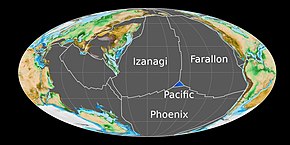
Back أبو المحيطات Arabic Panthalassa AST Pantalas Azerbaijani Панталаса Byelorussian Панталаса Bulgarian Pantalassa Catalan Panthalassa Czech Panthalassa Danish Panthalassa German Panthalassa Spanish



Panthalassa, also known as the Panthalassic Ocean or Panthalassan Ocean (from Greek πᾶν "all" and θάλασσα "sea"),[1] was the vast superocean that encompassed planet Earth and surrounded the supercontinent Pangaea, the latest in a series of supercontinents in the history of Earth. During the Paleozoic–Mesozoic transition (c. 250 Ma), the ocean occupied almost 70% of Earth's surface, with the supercontinent Pangaea taking up less than half. The original, ancient ocean floor has now completely disappeared because of the continuous subduction along the continental margins on its circumference.[2] Panthalassa is also referred to as the Paleo-Pacific ("old Pacific") or Proto-Pacific because the Pacific Ocean is a direct continuation of Panthalassa.
- ^ "Panthalassa". Online Etymology Dictionary.
- ^ Isozaki 2014, Permo–Triassic Boundary Superanoxia and Extinction, pp. 290–291
© MMXXIII Rich X Search. We shall prevail. All rights reserved. Rich X Search